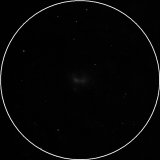
| MESSIER 76 |
|---|
RA: |
01h 42m 24s |
|
DEC: |
+51° 34' 00'' |
|
Type: |
Planetary nebula |
|
NGC: |
650, 651 |
|
Magnitude: |
10.40 |
|
Surface brightness : |
11.00 |
|
Apparent dimensions : |
2.7'x1.8' |
|
Distance: |
3,400 ly |
|
Planetary Nebula M76 was discovered by Pierre Méchain on September 5, 1780, who reported it to Charles Messier, who observed it on October 21, 1780, determined its position and added it to his catalog. M76 is among the fainter Messier objects. It is known under the names Little Dumbbell Nebula (the most common), Cork Nebula, Butterfly Nebula, and Barbell Nebula, and it was given two NGC numbers as it was suspected to be a double nebula with two components in contact, a hypothesis brought up by William Herschel, who numbered the "second component" H I.193 on November 12, 1787. NGC 651 is the North following (East) part of the nebula. The appearance of M76 resembles to some degree that of the Dumbbell Nebula M27. Most probably, the main body (the bar, or cork) is a bright and slightly elliptical ring we see edge-on, from only a few degrees off its equatorial plane. This ring seems to expand at about 42 km/sec. Along the axis perpendicular to this plane, the gas expands significantly more rapidly to form the lower surface brightness "wings" of the butterfly. As is not unusual for planetary nebulae, the distance is poorly known, with estimates between 1,700 and 15,000 light years. |
||
VEDRAN VRHOVAC© 2006.-2007. |
